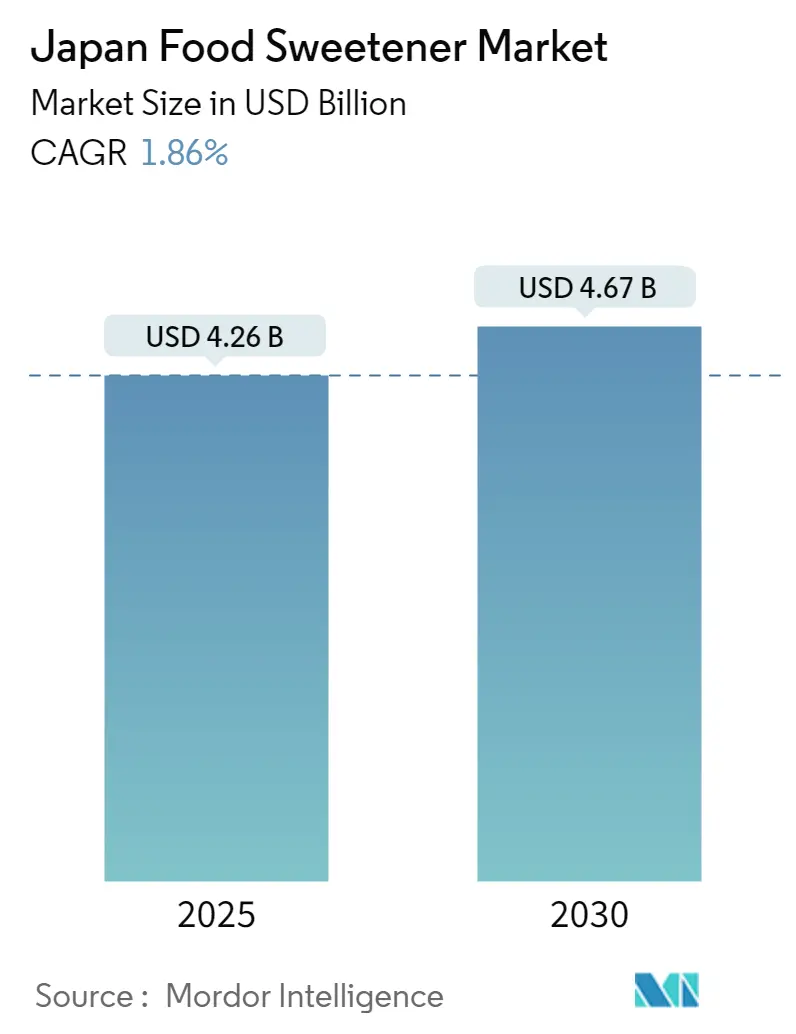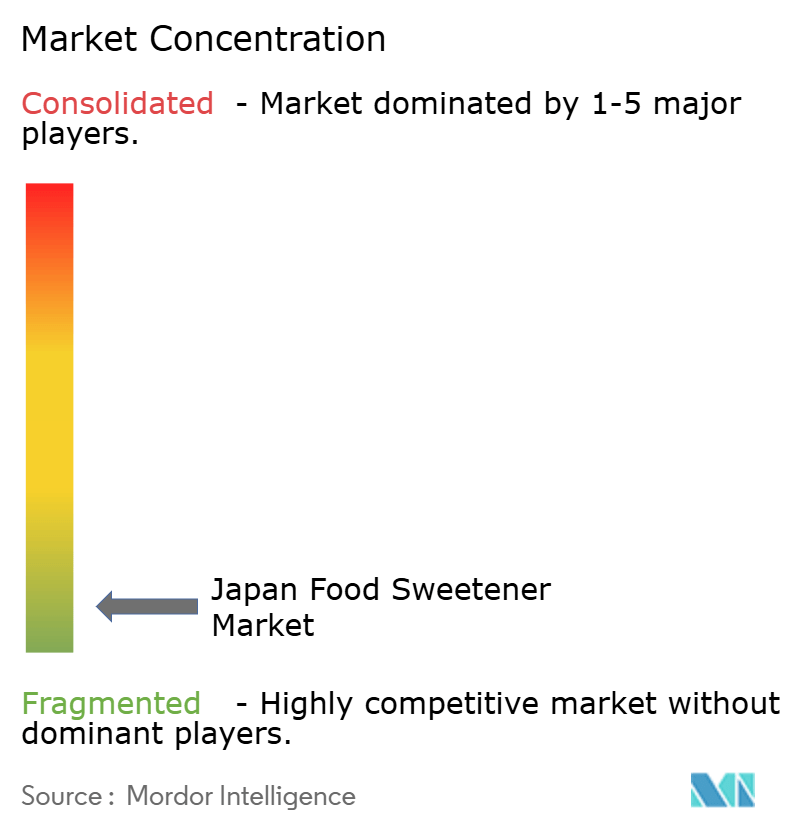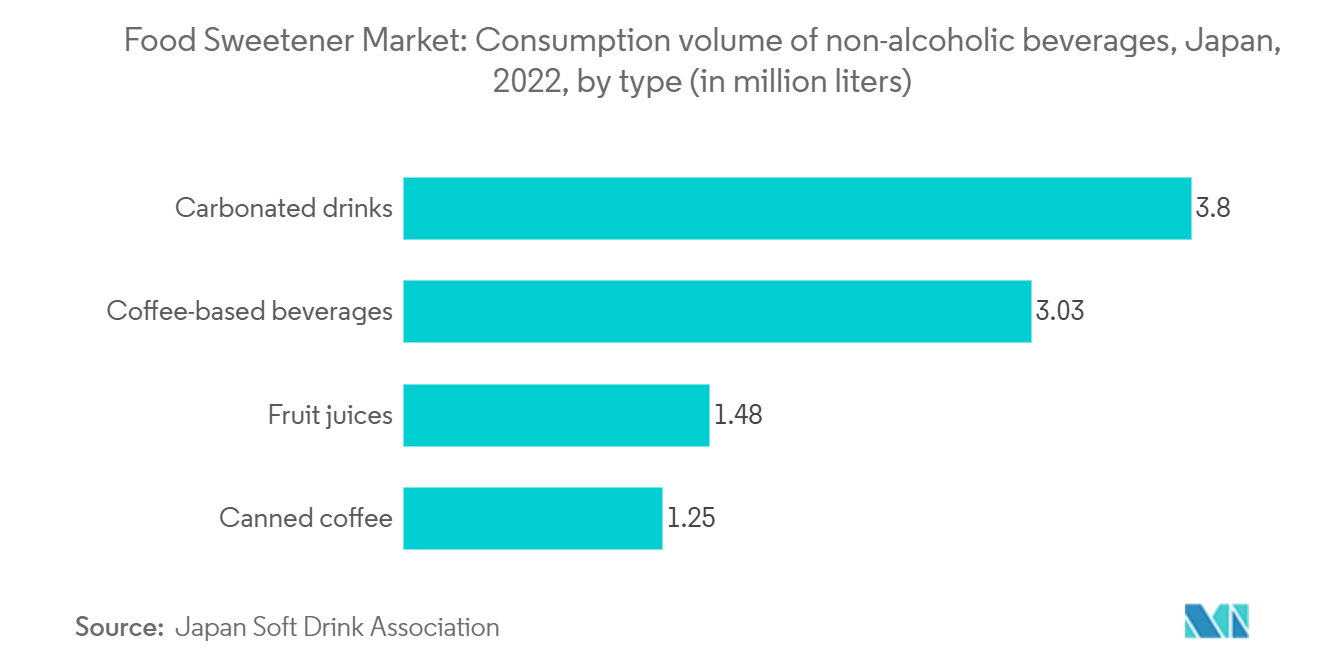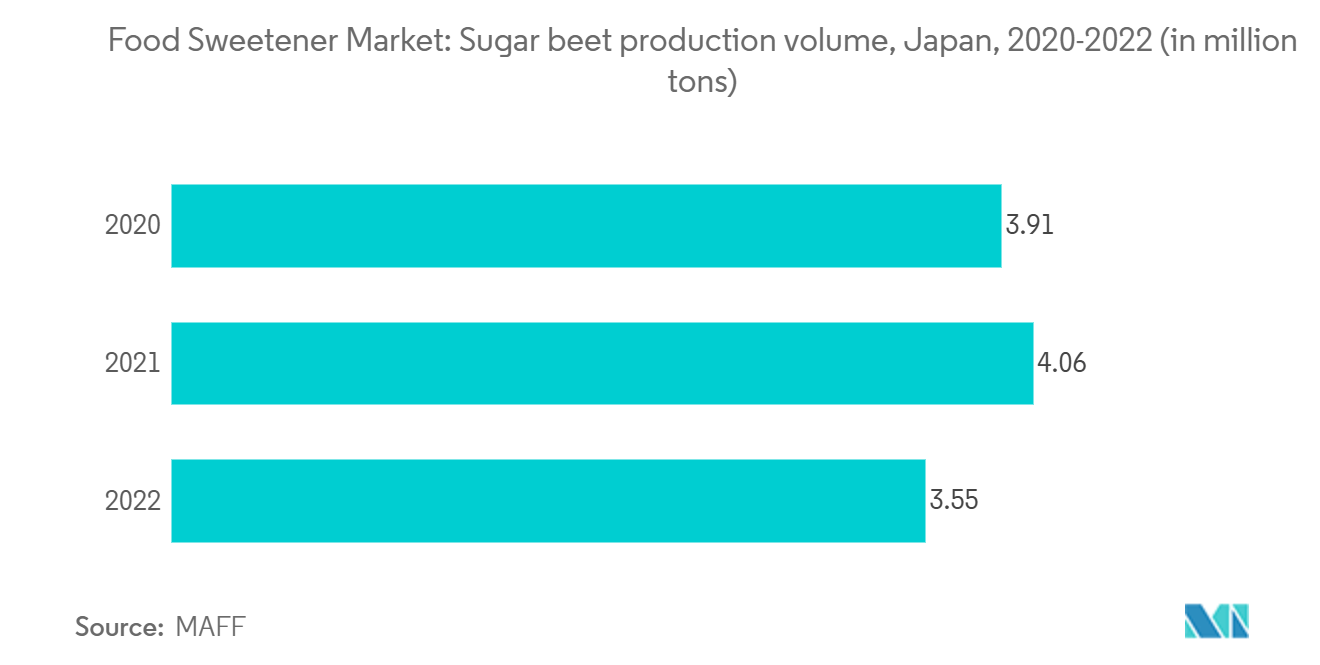
| Study Period | 2019 - 2030 |
| Base Year For Estimation | 2024 |
| Forecast Data Period | 2025 - 2030 |
| Market Size (2025) | USD 4.26 Billion |
| Market Size (2030) | USD 4.67 Billion |
| CAGR (2025 - 2030) | 1.86 % |
| Market Concentration | Low |
Major Players.webp)
*Disclaimer: Major Players sorted in no particular order |
Japan Food Sweetener Market Analysis
The Japan Food Sweetener Market size is estimated at USD 4.26 billion in 2025, and is expected to reach USD 4.67 billion by 2030, at a CAGR of 1.86% during the forecast period (2025-2030).
In Japan, food and beverage manufacturers are increasingly incorporating low-calorie sweeteners into products such as Diet Coke, juices, yogurt, ice cream, and grain-based desserts. Frembassy reported in January 2023 that 13% of Japanese consumers favored low-sugar options, while 8.3% chose products without additives or those labeled organic. Sugar substitutes like xylitol, dextrose, and sorbitol are seeing heightened consumption across diverse segments. These include bakery and confectionery items, meat products, beverages, soups, sauces, dressings, as well as dairy and desserts. This uptick is fueled by rising consumer awareness, government regulations targeting sugar consumption, and the incorporation of these substitutes in numerous health-focused food products. Furthermore, the stevia market in Japan is buoyed by heightened consumer awareness of dietary foods and a growing demographic of overweight, obese, and diabetic individuals.
After regulators like the Ministry of Health, Labor and Welfare (MHLW) approved sugar substitutes for consumer products, food and beverage companies quickly adopted these additives, drawn by their low caloric content and positive effects on blood sugar levels. A notable example is the approval of "advantame," a new non-caloric sweetener from Japan's Ajinomoto Co, by U.S. regulators, allowing its use as an alternative to sugar or high fructose corn syrup in various food and beverage items. Major market players, including Cargill, Incorporated, Ajinomoto Co., Inc., The Archer-Daniels-Midland Company, and Tate & Lyle PLC, are launching new products to secure a competitive edge. For instance, in November 2022, Tate & Lyle PLC introduced Erytesse Erythritol, a sweetener with 70% of sucrose's sweetness and a similar temporal profile, boasting zero calories. This sweetener is versatile, suitable for beverages, dairy, bakery items, and confectionery, and is being marketed both in Japan and globally.
Japan Food Sweetener Market Trends
High Consumption of Beverages Drive Demand for Sweeteners
Sweeteners play a crucial role in both alcoholic and non-alcoholic beverages, enhancing taste, reducing calories, balancing flavors, and aligning with consumer preferences. They are essential for achieving a harmonious flavor balance, blending sweet, sour, bitter, and acidic notes for a comprehensive taste experience. Furthermore, with the rising emphasis on health and wellness, consumers are gravitating towards beverages with reduced sugar content. Sweeteners address this shift, facilitating the creation of low-sugar or sugar-free alternatives.
In Japan, the sports drink sector has shown a consistent demand for sugar-based sweeteners, a trend fueled by the vibrant sports and fitness culture. Renowned for their balanced mix of electrolytes, sugars, and nutrients, Japanese sports drinks prioritize hydration and recovery. Sugar-based sweeteners, like sucrose and glucose, are integral to these formulations, offering rapid energy release—a feature highly valued by athletes and fitness aficionados. Brands like Pocari and Sweat prominently incorporate these sweeteners, emphasizing their role in restoring electrolytic and water balance post-exercise or during dehydration. Moreover, many Japanese consumers view sugar-sweetened sports drinks as a swift energy boost for daily activities, extending beyond just exercise. This perception, coupled with the rising production of sports drinks in Japan—evidenced by a jump from 1.24 million kiloliters in 2021 to 1.44 million kiloliters in 2023, as reported by the Japan Soft Drink Association—has driven up the demand for sugar sweeteners. The market is populated by both domestic and international players who are ramping up production capacity and expanding operations to solidify their market presence. A testament to this trend is Conagen's March 2022 move to boost its production capacity for two new high-intensity natural sweeteners, thaumatin and brazzein, post regulatory nod from Japanese authorities. These sweeteners, now making waves in the beverage sector, serve as effective sugar substitutes.
Sucrose Is Preferred Over Other Types
Japan primarily sources its sugar production from sugar cane and sugar beets. The Statistics Bureau of Japan reported that in 2022, sugar beet production reached approximately 3.55 million tons. Sucrose, commonly known as 'table sugar' or 'cane sugar,' finds extensive application across multiple sectors. Available in powdered, granulated, or liquid forms, sucrose is predominantly utilized by food and beverage manufacturers. Its significance is underscored in traditional Japanese cuisine, where sucrose is essential for the authentic flavor of numerous desserts, beverages, and dishes, leading to a steady demand. Notably, it is a key ingredient in popular items such as sushi rice, sauces, stews, pickles, and marinades.
With the increasing consumption of processed foods, bakery items, soft drinks, and confectioneries, the demand for sucrose is on the rise. Beyond its sweetening properties, sucrose acts as a stabilizer, preservative, and texturizer, further fueling its market growth. Its unique taste and versatility make it irreplaceable without compromising food sensory properties. The market for ready-to-drink (RTD) tea, coffee, fruit juices, and carbonated beverages is on the rise, with sucrose as a primary ingredient. As reported by Asahi Group Holdings, in 2023, RTD tea commanded a 30% share of Japan's soft drink market, trailed by RTD coffee at 18% and carbonated beverages at 15%. This trend heightens the demand for sucrose among Japanese beverage producers. Major companies manufacture a diverse range of sucrose ingredients, predominantly supplying them as bulk sweeteners for various industrial uses.
Japan Food Sweetener Industry Overview
The food sweetener market in Japan is fragmented, featuring key players like Cargill, Incorporated, Nagase & Co. Ltd, Mitsui DM Sugar Holdings Co., Ltd, Mitsubishi Corporation, and Ajinomoto Co. Inc., among others. Major food processing firms are prioritizing the introduction of innovative products, emphasizing low-calorie and natural ingredients, in response to the rising consumer demand for healthier food choices. To enhance their brand visibility, these companies are further employing strategies such as mergers, expansions, acquisitions, partnerships, and the development of new products.
Japan Food Sweetener Market Leaders
-
Cargill, Incorporated
-
Ajinomoto Co. Inc.
-
Mitsubishi Corporation
-
Mitsui DM Sugar Holdings Co., Ltd
-
Nagase & Co. Ltd
- *Disclaimer: Major Players sorted in no particular order

Japan Food Sweetener Market News
- June 2024: Japan's Morinaga & Company, operating under the brand "In Jelly," unveiled an innovative beverage named "In Tansan." Housed in a soda can, this unique drink undergoes a transformation upon ingestion. It reacts with stomach acids, morphing into a denser jelly that helps suppress appetite. Offered in lemon and dry grapefruit flavors, the dry grapefruit option is calorie-free, whereas the lemon variant has just 18 calories, due to the inclusion of sweeteners Stevia and monkfruit.
- June 2024: Morita Kagaku Kogyo introduced a next-gen line of stevia-based sweeteners, prominently featuring Rebaudioside M (Reb M) alongside other steviol glycosides. This new sweetener range emphasizes a high-purity Reb M profile, celebrated for its clean, sugar-like flavor with minimal bitterness. This characteristic makes it particularly suitable for applications demanding high sweetness intensity without undesirable aftertastes.
- May 2024: JK Sucralose Inc. initiated its sucralose technical transformation project in the Economic Development Zone of Sheyang Port, located by the Yellow Sea. With an annual production capacity set at 4,000 tons, the project boasts an investment surpassing CNY 1 billion. Spanning an additional 390,000 square meters, the site allocates nearly 100,000 square meters for new production facilities and essential infrastructure. Once fully operational, the project anticipates an impressive output value of CNY 2 billion.
Japan Food Sweetener Industry Segmentation
Sweeteners are food additives that impart a sweet taste to food and beverage products.
The food sweetener market in Japan is segmented by type and application. Based on the type, the market is segmented into sucrose, starch sweeteners and sugar alcohols, and high-intensity sweeteners (HIS). Starch sweeteners and sugar alcohols are further sub-segmented into dextrose, high fructose corn syrup (HFCS), maltodextrin, sorbitol, xylitol, and other starch sweeteners and sugar alcohols. The high-intensity sweeteners (HIS) are further sub-segmented into sucralose, aspartame, saccharin, neotame, stevia, cyclamate, acesulfame potassium (Ace-K), and other applications. Based on the application, the market is segmented into bakery and confectionery, dairy and desserts, beverages, meat and meat products, soups, sauces and dressings, and other applications.
For each segment, market sizing and forecast have been done based on value (USD).
| Product Type | Sucrose | ||
| Starch Sweeteners and Sugar Alcohols | Dextrose | ||
| High Fructose Corn Syrup | |||
| Maltodextrin | |||
| Sorbitol | |||
| Xylitol | |||
| Other Starch Sweeteners and Sugar Alcohols | |||
| High-intensity Sweeteners (HIS) | Sucralose | ||
| Aspartame | |||
| Saccharin | |||
| Cyclamate | |||
| Acesulfame potassium (Ace-K) | |||
| Neotame | |||
| Stevia | |||
| Other High-intensity Sweeteners | |||
| Application | Bakery and Confectionery | ||
| Dairy and Desserts | |||
| Beverages | |||
| Meat and Meat Products | |||
| Soups, Sauces, and Dressings | |||
| Other Applications | |||
Japan Food Sweetener Market Research Faqs
How big is the Japan Food Sweetener Market?
The Japan Food Sweetener Market size is expected to reach USD 4.26 billion in 2025 and grow at a CAGR of 1.86% to reach USD 4.67 billion by 2030.
What is the current Japan Food Sweetener Market size?
In 2025, the Japan Food Sweetener Market size is expected to reach USD 4.26 billion.
Who are the key players in Japan Food Sweetener Market?
Cargill, Incorporated, Ajinomoto Co. Inc., Mitsubishi Corporation, Mitsui DM Sugar Holdings Co., Ltd and Nagase & Co. Ltd are the major companies operating in the Japan Food Sweetener Market.
What years does this Japan Food Sweetener Market cover, and what was the market size in 2024?
In 2024, the Japan Food Sweetener Market size was estimated at USD 4.18 billion. The report covers the Japan Food Sweetener Market historical market size for years: 2019, 2020, 2021, 2022, 2023 and 2024. The report also forecasts the Japan Food Sweetener Market size for years: 2025, 2026, 2027, 2028, 2029 and 2030.
Our Best Selling Reports
Japan Food Sweetener Industry Report
Statistics for the 2025 Japan Food Sweetener market share, size and revenue growth rate, created by Mordor Intelligence™ Industry Reports. Japan Food Sweetener analysis includes a market forecast outlook for 2025 to 2030 and historical overview. Get a sample of this industry analysis as a free report PDF download.






